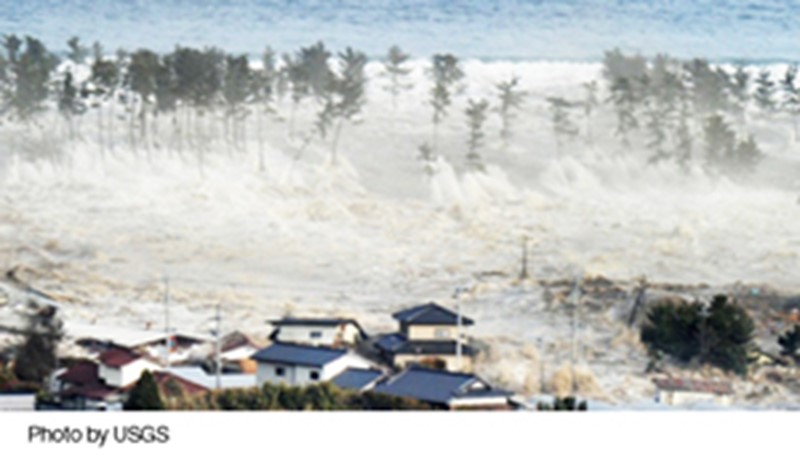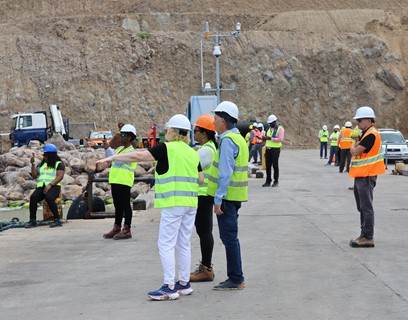
The extraordinary scenes of the tsunami that resulted from the biggest earthquake in Japan's history has brought into focus the potential catastrophe that could result if a similar event was to hit the Caribbean.
The 8.9 magnitude earthquake that struck northern Japan took place at 2:46PM local time (0546 GMT) at a depth of approximately 24km below sea level. The destruction that has been left behind has demonstrated that even the best-laid preparation plans for a disaster can be thrown into chaos when nature decides to wreak havoc.
The tragedy of the resulting tsunami led me to consider if such an event on the scale of what we are witnessing in Japan can occur in the Caribbean region? According to scientific analysis, the quake and its aftershocks occurred in a region of volatility within the earth's crust.
What is most striking to me when looking at the situation in Japan is that experts are universally agreed that Japan and California are two of the world's best monitored regions for tsunami's and earthquakes, with sophisticated structures in place.
The tsunami that resulted from the Japanese earthquake sent a ten-metre wall of water surging over ten kilometres inland. The harrowing images from Japan made me wonder if the topography of some Caribbean islands could survive the effects of a great tsunami such as Japan's.
The threat of a tsunami taking place in the Caribbean region is a very real possibility. Scientific studies have shown that the region is considered to have a moderate to severe level of seismic activity. Further research I have encountered undertaken by the University of the West Indies Seismic Research Unit (SRU), indicate that at least three earthquakes spiking over a magnitude 7.0 have taken place in the region. This is inclusive of the quake that hit Haiti in January of 2010.
Another significant fact when looking at the very real threat of a tsunami in the Caribbean, is that the region's territories sit in an area where fault lines between the earth's plates and deep sea trenches cause what geologists refer to as stresses' that can lead to earthquakes. Some parts of the region are actually perched on what can be described as an expansive underwater ridge. The Puerto Rico Trench is thought to be the deepest part of the Atlantic Ocean, with depths beyond 8,300 meters.
According to the US Geological Survey in their Caribbean Tsunami and Earthquake Hazards Studies, "The depth of this trench is comparable to the deep trenches in the Pacific Ocean. The Puerto Rico Trench is also associated with the most negative gravity anomaly on earth, which indicates the presence of an active downward force."
They went on further to state, "Puerto Rico, the Virgin Islands to its east, and eastern Hispaniola to its west, are located on an active plate boundary zone between the North American plate and the northeast corner of the Caribbean plate.....the geologic settings of Puerto Rico and the Virgin Islands have created or contributed to several pressing societal issues related to human safety, environmental health, and economic development.
Because the island lies on an active plate boundary, earthquakes are a constant threat, and the densely populated coastal areas are vulnerable to tsunamis."
In 2010 Peter Koltermann, Executive Secretary of the United Nations Intergovernmental Oceanographic Commission, told a meeting of around 30 Caribbean states that the likelihood of a tsunami hitting the region at some stage was "probable". He went on to state that the earthquake and resulting tsunami in the Indian Ocean in 2004 was similar to the Caribbean, in that no one believed it would happen, but yet it did.
With Caribbean states already feeling the pressure of having to compete in an increasingly competitive global market place, the economic fall out from any tsunami hitting the region on the scale of Japan or the Indian Ocean tsunamis would be catastrophic.
Tourism, which is a major earner for many Caribbean states, would suffer immense damage. Trade links too would be severely affected as many of the region's goods are transported via sea. The social and infrastructure breakdown would be another major casualty. Particularly, as our small island states are developing countries', thus even those countries with advanced infrastructure systems are still seeking ways to improve and provide better services for their people. Those who are not there yet will be thrown a huge deficit to rebuild and bring their societies back towards efficient infrastructural systems.
Caribbean governments have recognised the need for planning and have made moves to set up a joint tsunami warning centre that would provide an early warning system to help prevent loss of life and any other infrastructure damage. As Japan has proven, no early warning system can prevent loss of life but at least it can serve to minimise the loss.
In collaboration with Caribbean governments, the UNESCO Intergovernmental Oceanographic Commission (IOC) and the United States, the Caribbean region is protected by real time reporting seismic stations for detecting earthquakes. There are also three deep-ocean detection systems for tsunamis and also stations for monitoring sea level shifts.
The United Nations Development Programme has also provided funding for Barbados to host a Caribbean Tsunami Information Centre that serves to sensitise and inform local communities on how to respond in the event of a Tsunami.
It is my hope that the Caribbean will be spared the potentially crippling effects of a major tsunami taking its toll on low-lying territories. Experts have however told the Reuters news agency that although most tsunamis occur in the Pacific Ocean, they estimate that in the last 500 years, there have been around 105 tsunamis in the Caribbean including one in Panama in 1882, which took 4,500 lives.
Hence the Caribbean and its people must be aware & prepare for the very real threat of a tsunami.
Jeevan Robinson is Editor-in-Chief of MNI Alive. He can be contacted at jeevan@mnialive.com


